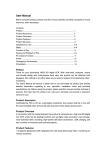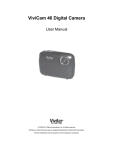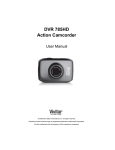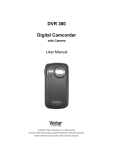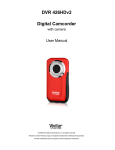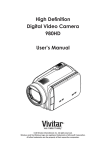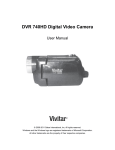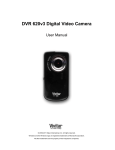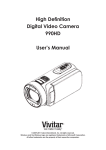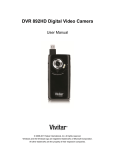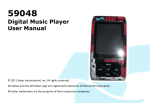Download Vivitar VIV-CV-1225V User manual
Transcript
VIV-CV-1225V Digital Binocular Camera User Manual © 2010 Sakar International, Inc. All rights reserved. Windows and the Windows logo are registered trademarks of Microsoft Corporation. All other trademarks are the property of their respective companies. Contents Introduction .................................................................................................................................. 2 What‟s Included ............................................................................................................................ 2 Computer System Requirements – WINDOWS OS ..................................................................... 3 Computer System Requirements – MAC OS ............................................................................... 3 Parts of the Camera ..................................................................................................................... 4 Initial Camera Setup ..................................................................................................................... 5 Powering ON/OFF Your Digital Camera ....................................................................................... 7 Camera Button Functionality ........................................................................................................ 8 Photo Capture (Shoot) Mode ....................................................................................................... 9 Menu Mode: Changing the Camera Settings ............................................................................. 10 Menu Mode: Changing the General Camera Settings ................................................................ 14 Playback Mode ........................................................................................................................... 17 Binocular Feature ....................................................................................................................... 17 Installing the Software ................................................................................................................ 18 Connecting the Camera to the Computer ................................................................................... 19 Getting Photos from your Camera to Your Computer ................................................................. 20 Get started!................................................................................................................................. 21 Transfer media from my camera to my computer manually (Using Windows) ............................ 22 Transfer media from my camera to my computer manually (Using Macintosh) .......................... 22 Camera Maintenance ................................................................................................................. 23 Sakar Warranty Card .................................................................................................................. 24 Technical Support ....................................................................................................................... 25 Troubleshooting.......................................................................................................................... 25 1 Introduction Thank you for purchasing this Digital Binocular Camera. This device can be used as a digital camera as well as binoculars. Everything you need to take quality digital photos is included with your camera. Vivitar makes capturing those special moments as easy as possible. Please read this manual carefully first in order to get the most out of your digital camera. Note: Your camera needs an SD Memory card (up to 8GB) for normal use. SD Memory cards are not included and need to be purchased separately. What’s Included 1) Digital Binocular Camera 2) USB cable 3) Vivitar Experience Image Manager software Installation CD 4) Attached Neck Strap Note: SD Memory Card and batteries not included. 2 Computer System Requirements – WINDOWS OS To be able to download photos to your PC, you will need the following minimum configuration: Microsoft® Windows XP with Service Pack 3, Windows Vista with Service Pack 1 or Windows 7 Pentium® 4 processor (or above) 250 MB available hard disk space 512 MB of RAM 16-bit Color monitor 1024 X 768 Recommended screen resolution CD ROM Drive QuickTime® 6 or higher Microsoft® Internet Explorer 7 or higher Windows Media Player 10 or higher DirectX 9 or higher Internet connection required Computer System Requirements – MAC OS Intel processor running Mac OS X v10.5 or later 250 MB available hard disk space 256 MB RAM Display: 1024 x 768 or higher-resolution monitor QuickTime® 6 or higher Internet connection required 3 Parts of the Camera LCD Screen Next Button Eyepiece Focus Knob Preview/OK Button Screen Button Shoot/Right Button USB Slot / SD Card Slot MENU/Left Button Power Button Battery Compartment Telescopic Funnel 4 Initial Camera Setup INSTALLING THE BATTERIES 1) Slide Open the battery compartment, located on the bottom of the camera. 2) Insert 2 x AA (1.5V) batteries. 3) Alkaline batteries are recommended. 4) Close the battery compartment. Battery Indictor When your camera is powered on, an icon indicating how much battery power remains can be seen on the top left section of the LCD screen. There are 4 icons indicating your battery power consumption level: Full Battery Two lattice – battery half full One lattice – battery ¼ full Empty Battery – replace the batteries INSTALLING THE SD MEMORY CARD 1) An SD Memory Card (up to 8GB) must be installed in the camera for normal use. 2) IMPORTANT: The camera will not capture photos without an SD card. SD Memory Cards are not included and must be purchased separately. 3) Flip open the SD Card Slot cover. 4) Insert the SD Memory Card until a click sound is heard. 5) Make sure the SD card is properly inserted. When the camera is powered on, and SD icon can be seen on the bottom right of the LCD screen. This indicates that the SD card is properly inserted. If the SD card is not properly inserted, the SD icon is shown with a red „X‟ the center of the LCD screen an alert icon appears 5 . and in If the SD card is locked, an SD icon with a key appears in the center of the LCD screen. In order to continue capturing images take the SD card out, unlock it then reinsert the SD card. If the SD card is full, an SD icon with a red rectangle appears in the center of the LCD screen. This indicates that no further images can be captured. In order to continue capturing images you can: - select images to delete using the Delete menu options in Playback Mode. - save your captured images by copying the images from the SD card onto your computer then deleting them from your SD card (using the Vivitar Experience Image Manager or manually – see related topics in Manual). - insert a new SD card with free space. Note: When you insert or remove an SD card, the camera will shut off automatically. 6 Powering ON/OFF Your Digital Camera Make sure the batteries have been inserted properly into your digital camera. Insert 2 AA Batteries (1.5V) in the battery compartment of your camera. Alkaline batteries are recommended. Make sure an SD Memory card has been inserted into your camera. (SD card up to 8GB - SD Card not included) POWERING THE CAMERA ON 1) Press and hold for 3 seconds the Power button to turn your camera ON. 2) The camera will emit a beep and the LCD monitor will light up. Note: When there is an SD card inserted, it may take a bit longer for the LCD monitor to activate. 3) The camera will be in Photo Capture (Shoot) Mode to start. POWERING THE CAMERA OFF While the camera is on, you can press and hold for 2 seconds the Power button again at any point to turn your camera OFF. AUTO POWER OFF FEATURE Your digital camera also has an Auto Power Off feature that will automatically turn off your camera after three minutes of time that your camera is left idle. After sitting idle for 3 minutes, the camera will shut off completely and will need to be powered on again with the power button before the next use. The Auto Power Off settings can be set OFF or ON from the Auto Power Off settings in the camera Menu Mode options. 7 Camera Button Functionality Button Function Press to turn the camera on and off. POWER Press to open the Menu Mode. MENU / Left Press again to exit the Menu Mode. Press to open the Playback Mode. PREVIEW / OK Press again to exit the Playback Mode. When in Menu Mode: - Opens Submenu options. - Confirms selected submenu option. Press to Capture the image when in Photo SHOOT / Right Capture (Shoot) Mode. In Menu Mode, scrolls through menu and NEXT submenu options. Screen When the LCD screen is closed, the button is pressed and turns off the LCD screen. 8 Photo Capture (Shoot) Mode TAKING A PICTURE 1) Turn on your digital camera. 2) Flip up and open the LCD display. 3) The camera automatically opens to the Photo Capture (Shoot) Mode. 4) The 5) The amount of photos that can be captured with the available memory and as per the camera icon will appear on the top right corner of the LCD. selected resolution will appear on the bottom section of the LCD screen. Note: The amount shown is for your reference only since the actual picture size will vary according to the object you want to take a photo of and the surrounding environment. 6) Use the LCD display to direct the camera at the scene you would like to capture. The box in the center of the screen with the white border indicates the center for capturing your image. 7) Press the Shoot/Right button to capture and save your photo to the memory card. Note: There will be a short delay while the camera saves the photo in JPG format to your memory card. The preview of the captured photo will be shown for a moment on the LCD screen. When the Continuous Shot Mode feature is used, the 3 captured photos will all appear together on the LCD screen - 品 9 Menu Mode: Changing the Camera Settings The Menu Mode allows you to select and change the following specific Camera settings: Picture Size, Picture Quality, Exposure, White Balance, and Continuous Shot Mode. PICTURE SIZE Picture size allows you to select the picture quantity and quality that could be stored in the memory card. 1) Press the MENU button to enter the Menu Mode options. 2) Press the NEXT button to select the Picture Size icon that appears on the screen menu. 3) Press the OK button to determine the Picture Size option, and the corresponding picture size option is displayed in the center of LCD screen. 8M 3264×24488M 3264 × 2448 5M 2580×19365M 2560 × 1920 3M 2048×14403M 2048 × 1536 2M 1624×12802M 1600 × 1200 1.3M 1280×10241.3M 1280 × 960 VGA 640×480VGA 640 × 480 4) Press the NEXT button to highlight the various Picture Size options, and select your desired picture size option. 5) Press the OK button to select your option and save your choice. 6) Press the MENU button to exit and return to the camera standby mode. 7) The selected Picture Size icon will appear on the right side of the LCD screen. 10 PICTURE QUALITY The quality selected for your photo will affect the number of photos (with same memory card) that can be captured. High quality means that your camera can take less photos, but the photos are of better quality. The default picture quality is good. 1) Press the MENU button to enter the Menu Mode options. 2) Press the NEXT button to select the stars icon 3) Press the OK button to determine the quality option selected. The corresponding photo that appears on the screen menu. quality option is displayed in the center of LCD screen: Good; Standard; General; 4) Press the NEXT button to highlight the various Picture Quality options, and select your desired picture quality options. 5) Press the OK button to select your option and save your choice. 6) Press the MENU button to exit and return to the camera standby mode. 7) The selected Picture Quality icon will appear on the right side of the LCD screen. LIGHT EXPOSURE This setting allows you to control the brightness of the photo you would like to capture. 1) Press the MENU button to enter the Menu Mode options. 2) Press the NEXT button to select the Light Exposure icon that appears on the screen menu. 3) Press the OK button to determine the Light Exposure options. The corresponding exposure compensation option is displayed in the center of LCD screen: -2.0 EV (darker) to +2.0 EV (lighter). Each change is made by increments of 0.5 EV. 4) Press the NEXT button to highlight the various Light Exposure options, and select the option you want. 5) Press the OK button to select your option and save your choice. 11 6) Press the MENU button to exit and return to the camera standby mode. 7) The selected Light Exposure icon will appear on the left side of the LCD screen. WHITE BALANCE The White Balance feature allows your camera to adjust the coloring of the captured images depending on the type of light source in the current environment. Properly adjusting the White Balance setting to match your current environment will allow the camera to properly balance the colors in the images that are taken with your camera. 1) Press the MENU button to enter the Menu Mode options. 2) Press the NEXT button to select the White Balance icon that appears on the screen menu. 3) Press the OK button to determine the White Balance options. The following White Balance options are displayed on the LCD screen. Automatic; 4) 晴天; Sunny; 阴天; Cloudy; Bulb; Fluorescent Press the NEXT button to highlight the various White Balance options, and select the option you want. 5) Press the OK button to select your option and save your choice. 6) Press the MENU button to exit and return to the camera standby mode. 7) The selected White Balance icon will appear on the right side of the LCD screen. CONTINUOUS SHOT MODE This setting allows you to take three rapid snapshots in a row with a single click of the „Shoot‟ button. 1) Press the MENU button to enter the Menu Mode options. 2) Press the NEXT button to select the Continuous Shot icon that appears on the screen menu. 3) Press the OK button to determine the Continuous Shot option. The following Continuous Shot options are displayed on LCD screen: 12 Takes continuous photos Takes a single photo 4) Press the NEXT button to highlight and select the Continuous Shot you want to use. 5) Press the OK button to select your option and save your choice. 6) Press the MENU button to exit and return to the camera standby mode. 7) The selected icon will appear on the bottom left side of the LCD screen. Single Shot Mode; Continuous Shot Mode 13 Menu Mode: Changing the General Camera Settings The Menu Mode allows you to select and change the following settings to adjust the camera according to your usage: Format Memory Card, Auto Power Off, and Frequency. FORMAT MEMORY CARD You can use the Format Memory Card menu to delete all of the content that is currently on your camera‟s memory card. Keep in mind that formatting the memory card will permanently delete all of the content on your camera’s memory card. This option will delete all of the content at one time. If you would like to delete individual images, use the delete menu in the camera‟s Playback mode. 1) Press MENU button to enter the Menu Mode options. 2) Press the RIGHT button to enter the General menu of camera settings mode 3) Press the LEFT button to return to the change of camera mode settings menu. 4) Press the NEXT button to select the Format Disk icon that appears on the screen menu. 5) Press the OK button to select the Format option. The corresponding Format options are displayed on the LCD screen. Not formatted Formatted 6) Press the NEXT button to highlight the various Format options, and select the option you want. 7) Press the OK button to determine your options and save your choice. Note: The format process may take some time to complete. 8) Press the MENU button to exit and return to the camera standby mode. 14 AUTO POWER OFF You can use the Auto Power Off feature in order to conserve you camera‟s battery life. When the camera sits idle for three minutes, the camera will shut off completely and will need to be powered on again with the power button before the next use. 1) Press the MENU button to enter the Menu Mode options. 2) Press the RIGHT button to enter the General Menu of camera settings mode. 3) Press the LEFT button to return to the change of camera mode settings menu. 4) Press the NEXT button to select the Auto Power Off icon that appears on the screen menu. 5) Press the OK button to determine the Auto Power Off option. The following Auto Power Off options are displayed on the LCD screen: Disable the Auto Power Off Activate the Auto Power Off 6) Press the NEXT button to highlight the various Auto Power Off options, and select the option you want. 7) Press the OK button to select your option and save your choice. 8) Press the MENU button to exit and return to the camera standby mode. FREQUENCY The options in the Frequency menu represent the frequency of the electrical current in fluorescent lighting sources in your locale. If your camera is set to a frequency that does not match your country‟s electric current, you may see waves on the images taken by your camera. You can set on the optical frequency of camera according to your area (usually 60HZ for the United States, and 50HZ for Europe). 15 1) Press the MENU button to enter the Menu Mode options. 2) Press the RIGHT button to enter the General menu of camera settings mode 3) Press the LEFT button to return to the change of Camera Mode settings menu. 4) Press the NEXT button to select the Frequency icon that appears on the screen menu. 5) Press the OK button to determine the optical frequency option. 6) The corresponding optical frequency options are displayed in the center of LCD screen: 50Hz 60Hz 7) Press the NEXT button to highlight the various Frequency options, and select the option you want. 8) Press the OK button to select your option and save your choice. 9) Press the MENU button to exit and return to the camera standby mode. 16 Playback Mode The Playback Mode allows you to review and delete photos that you‟ve captured with your camera. DELETE PHOTOS 1) Press the PREVIEW button to enter the Playback Mode. 2) Press the MENU button to enter the Delete menu option. 3) Press the OK button to select the Delete option. 4) The following delete options are displayed on the LCD screen. Delete selected picture (single photo) Delete all pictures (all photos) 5) Press the NEXT button to highlight the desired options: Delete single photo / Delete multiple Photos option, and select the option you want. 6) Press the OK button to select your option. Another option will appear on the LCD screen. Do not delete and exit Delete 7) Press the NEXT button to highlight and select the option you want. 8) If you choose the „Delete single picture‟ option, only the selected picture is deleted. 9) If you choose the „Delete all pictures‟ option, all pictures in the SD card will be permanently deleted. Binocular Feature You can use your digital camera as binoculars as well. Look through the binocular lenses (either side) using the Eyepiece Focus Knob to focus on the scene. 17 Installing the Software You must be connected to the internet to install and run the Vivitar Experience Image Manager software. 1) Insert the installation CD into your CD-ROM drive. The installation screen should automatically open. 2) On PC: The Vivitar Experience Image Manager Installer window appears. If the window does not appear, open the application‟s CD/DVD drive and click on “Setup.exe” to launch the installer. 3) On Macintosh: Click the icon that appears on the desktop to install the Vivitar Experience Image Manager. 4) If you do not have internet access at the time of inserting the CD-ROM, connect to the internet and then click the “Install Vivitar Experience Image Manager” button to begin the installation. Note: If you do not have internet access, you can still download media from the camera. Click the 18 “How to transfer photos and videos from my camera to my computer” button for instructions. If you have internet access, the “Choose your language” window opens, choose your 5) language and click “Next” to open the next window. 6) Select your camera model from the list and click “Next” to open the next window. 7) Click “Next” to confirm your camera model selection and to install the application. 8) Please wait while the application is being installed on your computer. 9) Please review the license terms. On PC and Macintosh: Click the “I accept the terms of this license agreement” and then click “Next” to continue. 10) On PC only: Let the “Vivitar Experience Image Manager” installer create the folder to where the program will be installed, and then click “Install”. 11) Please wait while the application continues the installation process on your computer. 12) On PC: Click the “Close” button when the installation is complete. Click the “Launch Vivitar Experience Image Manager” to open the application. 13) On Macintosh: Close the System Preferences window that appears as the last step in the installation. The application automatically opens. 14) If you close the application you can run the Vivitar Experience Image Manager from the Programs (PC) or Applications (Mac) menu on your computer. Connecting the Camera to the Computer IMPORTANT: Before connecting your camera to the computer: - Make sure an SD memory card (up to 8GB) with your captured photos is inserted in the camera. 19 - Make sure the camera is powered off – otherwise it cannot be identified. - Your computer recognizes the camera as a separate hard drive and the name of this hard drive varies according to the operating system. 1) Use the USB cable that came with your camera to connect your camera to your computer. 2) The first time you connect the device to the computer you will have to wait a few seconds until the computer recognizes the device. Getting Photos from your Camera to Your Computer An SD card needs to be inserted. Do not disconnect the cable during transfer. Doing so will cancel the transfer of any files on their way to your computer. 1) Select the “Get Images” button from the Main menu. 2) The “Get Images from device” window opens. 3) You can select to download photos. 4) Select your camera (removable disk) from the device window. If your camera is the only USB device connected then it will be selected automatically. 5) Select a location on the computer where to place the new photo files. 20 6) Add the new photo files to albums if desired. 7) Select to remove the media files from the selected device (removable disk) after the import. 8) Click the “Get Images” button to transfer the photos from your camera to your computer. 9) A media download progress bar appears on the bottom left showing the number of media files downloading to your computer. A message appears when the download is complete. 10) The photo files that you selected are now downloaded to your computer to the selected folder and albums ready for your use. Get started! Using the Vivitar Experience Image Manager, you can: Upload and manage photos to and from the most popular photo sharing and social networking sites - Facebook, Flickr, Picasa, MySpace, Photobucket, Twitpic, Twitgoo and YouTube Seamlessly transfer photos from one social network to another Organize your images by creating offline and online albums Edit images using automatic and manual tools Use automatic “Geotagging” with built in Google Maps For more details on how to use the Vivitar Experience Image Manager open the Help file or click the “Take the Tour” button on the application`s Home page. 21 Transfer media from my camera to my computer manually (Using Windows) IMPORTANT: Before connecting your camera to the computer: - Make sure an SD memory card (up to 8GB) with your captured photos is inserted in the camera. - Make sure the camera is powered off – otherwise it cannot be identified. 1) Use the USB cable that came with your camera to connect your camera to your computer. 2) MSDC appears on the LCD. 3) A window appears with a list of options, select “Open folder to view files” and click OK. 4) Open the DCIM folder and the folder inside to view the media files. 5) Select the media and copy the files from this folder into your computer. Optionally, select the files and choose Copy from the Edit menu. Then select a folder and choose Paste from the Edit menu. 6) We recommend that you copy the images into the Pictures/My Pictures folder. 7) Do not disconnect the cable during transfer. Doing so will cancel the transfer of any files on their way to your computer. Transfer media from my camera to my computer manually (Using Macintosh) IMPORTANT: Before connecting your camera to the computer: - Make sure an SD memory card (up to 8GB) with your captured photos is inserted in the camera. - Make sure the camera is powered off – otherwise it cannot be identified. 1) Use the USB cable that came with your camera to connect your camera to your computer. 2) MSDC appears on the LCD. 3) The camera‟s device icon appears on the desktop. 4) Click on the device icon and open the DCIM folder and the folder inside to view the media 22 files. 5) Select the files and drag them into your computer. Optionally, select the files and choose Copy from the Finder‟s Edit menu. Then select a folder and choose Paste from the Edit menu. 6) We recommend that you copy the images into the Pictures folder. 7) Do not disconnect the cable during transfer. Doing so will cancel the transfer of any files on their way to your computer. Camera Maintenance The digital camera is a delicate device. Please handle your camera with care to avoid damaging it. Do not expose your camera to heat sources. Do not use you camera in wet or moist conditions. 23 Sakar Warranty Card This warranty covers for the original consumer purchaser only and is not transferable. Products that fail to function properly UNDER NORMAL USAGE, due to defects in material or workmanship will be repaired at no charge for parts or labor for a period of one year from the time of purchase. What Is Not Covered By Warranty: Damages or malfunctions not resulting from defects in material or workmanship and damages or malfunctions from other than normal use, including but limited to, repair by unauthorized parties, tampering, modification or accident. What To Do When Service Is Required: When returning your defective product (postage pre-paid) for service, your package should include: 8) Copy of original bill of sale 9) A detailed written description of the problem. 10) Your return address and telephone number (Daytime) MAIL TO ADDRESS BELOW: Sakar US Sakar UK/Europe Sakar Australia Sakar International Attention: Service Department Return faulty camera Attention: Service Department 2D, Siskin Parkway East to the Refund 195 Carter Drive 4020 Middlemarch Business Park Counter at the store Edison, NJ Coventry, CV3 4PE where purchased 08817 24 Technical Support For technical support issues please visit our website at www.vivitar.com. You can find manuals, software and FAQ‟s at the website. Can‟t find what you are looking for? E-mail us at [email protected] and one of our technical support team members will answer your questions. For phone support in the US please call 1-800-592-9541, in the UK call 0800 917 4831, in Australia call 1800-006-614. If you would like to call from anywhere else, please visit www.vivitar.com for your local toll free number. Troubleshooting Q: I have taken photos and selected the “Get Images” button. I get a message that the images were successfully transferred but the photos do not appear on my computer. What do I do? First ensure that you have in fact taken photos. Press the Shutter button to take some sample photos and then try downloading them again. With test photos if the camera powers off before you upload them to the computer the photos are not stored in the camera`s memory. These photos should be uploaded quickly before the camera powers off. If the photos are saved to the SD memory card then all the photos should appear. Q: How do I make sure I don't lose important pictures? This camera requires an SD card for normal use. If the camera powers off nothing will happen to the images stored on the SD memory card. We recommend always downloading your photos to your computer as soon as possible to prevent unintentional data loss. Q: I deleted images using the Vivitar Experience Image Manager. The images were also deleted from my computer. How do I recover images that I accidently deleted? All images deleted using the Vivitar Experience Image Manager are sent to your computer`s Recycle or Trash Bin and can be retrieved from there. VIV-CV-1225V -120610-TA_4 25


























